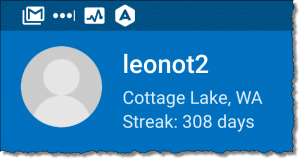I’m not a self-improvement junkie, but it’s certainly something that I have interest in. The process began years ago when one of my managers at Microsoft introduced me to an assortment of books and resources on the topic, most notably Stephen Covey’s The 7 Habits of Highly Effective People. Since then I’ve done a lot of reading, tried an assortment of time-management tools, watched videos, and tried various … I’ll call them “techniques”.
I ended last year over-techniqued.
You might note that I’ve not been writing here on my personal blog as often as I once was. Two reasons, really: burnout, and the holidays. But mostly burn out. As I approached my 60th birthday I did my 60 days of gratitude — both a sprint and a marathon of writing something every single day for nearly two months. It worked, and I’m glad I did it, but…
It left me tired. And, it happened prior to the holiday season. Particularly during Thanksgiving and Christmas it was simply easier to say “I’ll do it tomorrow”. The problem with saying that every day, however, is that things never get done.
But there was more to it than just writing. I’d actually started to track, using the Jerry Seinfeld strategy, an assortment of things that I wanted to happen daily: meditation, exercise, writing, idea generation, and a few more things that I can’t remember.
It took a freak’n spreadsheet.
If I wasn’t burned out before, that absolutely added to my level of discomfort. Rather than spurring me on to do all those things every day, it instead helped me to become resigned to the fact that I couldn’t, or wouldn’t, achieve what I’d set out to do.
Trying to do everything will kinda do that.
Just prior to the new year (because I didn’t want this to become associated as some “New Year’s Resolution” type of thing) I dumped the spreadsheet. After giving myself a few days to think about it, I decided instead to prioritize.
What one thing — if done consistently as part of my daily routine — would make the biggest difference? The answer, as they say, will surprise you.
Meditation. I’m not a particularly “woo”, touchy feely kinda guy, but since I began meditating (seven and a half years ago, measured by my purchase of 8 Minute Meditation) it’s been my empirical experience that I’m more focused and more productive on days when I meditate in the morning, and generally more scattered on days when I do not.
Based solely on my personal, empirical, experience that was the most important thing I could do.
So I decided to do it, and see how long I could keep the streak going. So far so good.
I also picked a number two at the same time, and that turned out to be more traditional: exercise. While it’s not practical for me to do it every single day, my commitment is to do it five days a week at least. Again, so far so good. (My exercise of choice: an elliptical, watching either some recorded TV for diversion, or YouTube videos for enrichment, depending on my mood.)
As the next month rolls up, I may elect to choose a number three. In fact, mirroring the experiments of Matt Cutts, doing something for 30 days feels like about the right number to commit to. It also collects enough data for me to decide at the end of that time whether or not that thing is worth continuing, modifying, or dropping completely.
What the next “thing” will be is unclear.
But having a structure, with more reasonable expectations, is likely to serve me much better than trying to do everything, all the time.
 Photo above: actually a screen shot of the app I often use to meditate. The 3.5K number is cumulative since I started using the app some time ago. The 30 days in a row indicator is, as I think about it, a gamification of the Seinfeld strategy: something my calorie counting app does as well (MyFitnessPal, shown here). The “problem” is that in order to have the app count the days for you, you need to use the app exclusively. I sometimes use something different, so at some point I expect the streak to be both broken (in the app) and not (in my head).
Photo above: actually a screen shot of the app I often use to meditate. The 3.5K number is cumulative since I started using the app some time ago. The 30 days in a row indicator is, as I think about it, a gamification of the Seinfeld strategy: something my calorie counting app does as well (MyFitnessPal, shown here). The “problem” is that in order to have the app count the days for you, you need to use the app exclusively. I sometimes use something different, so at some point I expect the streak to be both broken (in the app) and not (in my head).
